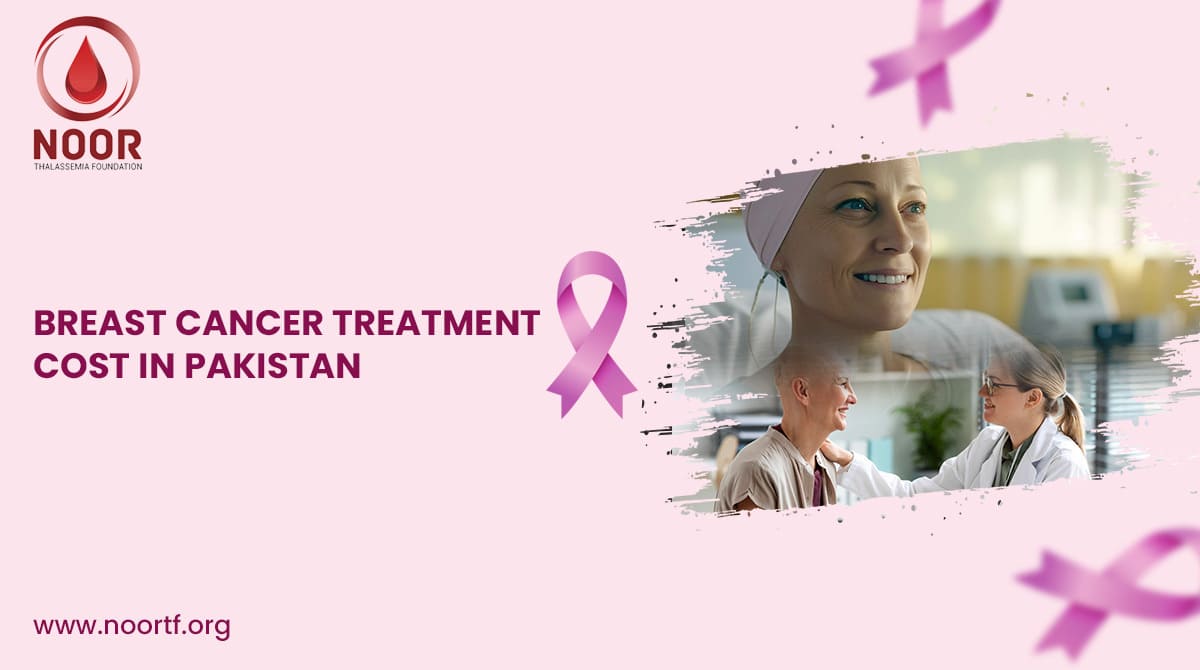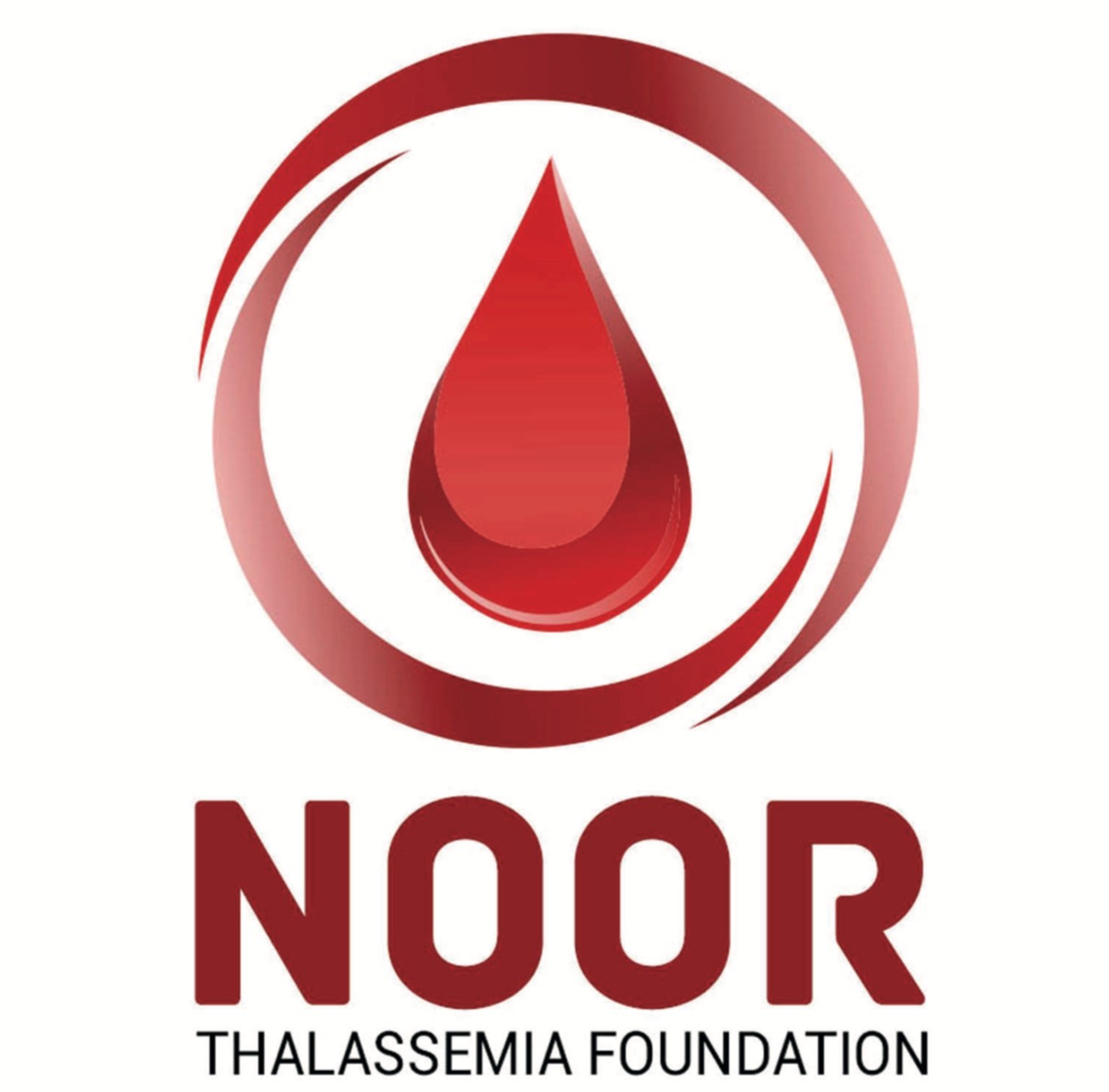Breast Cancer Treatment Cost in Pakistan
22-Jul-2025

Explore the complete guide to breast cancer including its symptoms, stages, treatment, and awareness. Learn how Noor Thalassemia Foundation supports free cancer care for patients in need.
One of the most prevalent and well-known types of cancer is breast cancer. It occurs when breast cells proliferate out of control, resulting in a lump or tumor. While it primarily affects women, men can also develop breast cancer, although at much lower rates. Millions of people worldwide are impacted by breast cancer, and those who are diagnosed as well as their families, communities, and healthcare systems all feel the effects. This article will cover the definition, signs, stages, available treatments, awareness, and other important aspects of breast cancer. We will also discuss breast cancer in Pakistan and offer useful resources for anyone looking for help, especially Noor Thalassemia Foundation, which provides free treatment to the patients in need.
Breast Cancer Meaning
When cells in the breast tissue grow abnormally, it's called breast cancer. When these cells proliferate out of control, a mass or tumor is created. The cancer may begin in the milk ducts (ductal carcinoma) or the glands that produce milk (lobular carcinoma), among other locations in the breast. Metastasis is the term for the process by which breast cancer cells can occasionally travel through the blood or lymphatic system to other areas of the body.
According to the kind of cells involved and their behavior, breast cancer can be divided into several types. Invasive ductal carcinoma (IDC), invasive lobular carcinoma (ILC), inflammatory breast cancer, and ductal carcinoma in situ (DCIS) are a few prevalent types of breast cancer. The prognosis, course of treatment, and reaction to therapy differ for each type.
Breast Cancer Symptoms
The type and stage of breast cancer can affect the symptoms. The following are a few of the most typical indications of breast cancer:
- Lump in the Breast: A hard, painless lump or mass in the breast tissue is often one of the first signs of breast cancer.
- Changes in Breast Shape or Size: Sudden changes in the shape or size of the breast, such as one breast becoming larger or more swollen, could indicate the presence of cancer.
- Pain or Tenderness: Pain in the breast or nipple area, especially if it is persistent, can sometimes be a sign of breast cancer.
- Skin Changes: Redness, dimpling, or puckering of the skin over the breast can be a warning sign.
- Nipple Discharge: Unexplained discharge from the nipple, especially if it is bloody or clear, may indicate a problem.
- Nipple Retraction: If the nipple becomes inverted or starts to pull inward, it may signal underlying issues.
It's important to note that not all lumps or changes in the breast are cancerous. Similar symptoms can also be caused by a variety of other conditions, including benign tumors or cysts. For a more thorough assessment and diagnosis, it is essential to consult a healthcare professional if any of these symptoms are observed.
Breast Cancer Awareness
Awareness of breast cancer is essential for prevention, treatment, and early detection. Many organizations and medical professionals work to raise public awareness of breast cancer and its effects throughout the year. This involves raising awareness via advertisements, screenings, and instructional resources.
Every October, Breast Cancer Awareness Month is one of the most well-known campaigns to increase public awareness of breast cancer. Efforts to raise awareness of the warning signs and symptoms of breast cancer are intensified during this month, frequently with the use of the recognizable pink ribbon. The objective is to support research for improved treatment options and to encourage people to get regular breast cancer screenings, such as mammograms.
The awareness campaigns also seek to emphasize the significance of early detection, since it has been demonstrated that breast cancer is easier to treat and control when detected early. Raising public awareness is essential to lowering the stigma associated with breast cancer, especially in nations or areas where the disease is frequently viewed as a taboo subject.
Breast Cancer Stages
The degree to which breast cancer has spread throughout the body is referred to as its staging. The phases assist medical professionals in assessing a patient's prognosis and choosing the best course of action. Generally, there are five stages of breast cancer:
- Stage 0: Also called carcinoma in situ, this is a non-invasive stage where abnormal cells are found but have not spread beyond the ducts or lobules.
- Stage 1: The cancer is small and localized, meaning it is confined to the breast tissue and has not spread to lymph nodes.
- Stage 2: The tumor has grown larger, and cancer may have spread to nearby lymph nodes.
- Stage 3: The cancer has spread to nearby tissues and lymph nodes, making it more advanced.
- Stage 4: This is the most advanced stage, where cancer has spread (metastasized) to distant parts of the body, such as the lungs, bones, or liver.
The stage of the cancer at diagnosis plays a significant role in determining the treatment plan and the patient's chances of recovery. Because early detection is crucial, cancers detected early tend to have better outcomes.
Breast Cancer Treatment
Breast cancer treatment options have undergone significant improvements in recent years. The type and stage of the cancer, the patient's overall health, and personal preferences are among the variables that influence the treatment plan. The primary therapies for breast cancer consist of:
Operation: This entails either removing the tumor or the breast entirely (mastectomy). The size and location of the tumor determine whether a mastectomy or a lumpectomy (removal of the tumor) is appropriate.
Chemotherapy: Chemotherapy uses drugs to either kill or stop the growth of cancer cells. To lower the chance of recurrence, it can be used either before surgery (neoadjuvant therapy) or after surgery (adjuvant therapy).
Radiation therapy targets and kills cancer cells by using high-energy rays. It is frequently used to eradicate any cancer cells that may still be present after surgery.
Hormone Therapy: Drugs that block the hormones that drive the growth and spread of cancer can be used to treat cancers that have hormone receptors.
Targeted therapy: These medications target particular molecules or pathways that contribute to the growth of cancer cells. This approach can be used in combination with other treatments.
Immunotherapy: Immunotherapy strengthens the body's defences against cancerous cells.
Doctors collaborate closely with patients to minimize side effects while ensuring the best possible outcome for each treatment.
Breast Cancer Treatment Cost in Pakistan
The expense of breast cancer treatment can be a major deterrent to access in many developing nations, including Pakistan, particularly for those with low incomes. For many patients, the cost of treatments like radiation, chemotherapy, surgery, and continuing care can be too much to bear. However, Noor Thalassemia Foundation are essential in helping those in need receive free breast cancer treatment.
The Noor Thalassemia Foundation provides financial support to patients who might not otherwise be able to afford treatment, thereby alleviating the burden of medical bills. Additionally, the foundation works to raise awareness of the illness and ensure that patients and their families are aware of the various treatment options available.
Care Plan for Breast Cancer
A comprehensive approach to managing breast cancer from diagnosis to recovery is part of a care plan. This strategy consists of:
- Routine examinations and screenings are conducted to monitor the patient's condition and identify any signs of recurrence.
- Nutritional counselling to ensure the patient maintains a nutritious diet that promotes recovery and overall well-being.
- Psychological assistance to deal with the mental and emotional difficulties that may come up while a person is battling cancer.
- Patients can meet others who are going through similar experiences through support groups.
Healthcare professionals can better manage patients' needs and enhance their quality of life by creating personalized care plans tailored to each individual's specific needs.
Frequently Asked Questions
What type of collagen causes breast cancer?
The protein collagen provides tissues, such as skin, cartilage, and bones, with their structure. Types of collagen do not directly correlate with the development of breast cancer. Nonetheless, alterations in the collagen composition of breast tissues could be a factor in the development and spread of tumors. The function of collagen in cancer biology remains an area of ongoing investigation.
What percentage of breast ultrasounds are cancer?
Breast ultrasounds are often used as a diagnostic tool to examine breast lumps or abnormalities detected during physical exams or mammography. However, only a small percentage of breast ultrasound results indicate cancer. Studies suggest that around 10-15% of breast lumps identified through ultrasound are malignant.
How I knew I had inflammatory breast cancer?
One uncommon and aggressive type of breast cancer is inflammatory breast cancer. It is characterized by breast redness, swelling, and warmth, and typically appears rapidly. People should get medical help right away if they experience these symptoms because this type of cancer needs to be diagnosed and treated right away.
What does breast cancer look like on ultrasound?
On an ultrasound, breast cancer may appear as an irregular mass or lump with distinct borders. The mass may be solid or contain areas of fluid. The surrounding tissue may show signs of inflammation or changes in texture.
What percentage of breast biopsies are cancer?
To test for the presence of cancer cells, tissue is removed during a breast biopsy procedure. A person's risk factors and the results of their initial screening determine the likelihood that a biopsy will reveal cancer. About 20–30% of breast biopsies are diagnosed with cancer on average.
Do parasites cause breast cancer?
There is no scientific evidence to suggest that parasites directly cause breast cancer. However, certain infections or chronic inflammation can contribute to an increased risk of various types of cancer, but the role of parasites in breast cancer development is not supported by current research.
History of breast cancer ICD-10?
Breast cancer can be coded using a standardized system provided by the International Classification of Diseases (ICD-10). Malignant Neoplasm of the Breast (C50) codes are used to classify breast cancer, and the type and location of the cancer determine which subcategories are used.
Stage 4 breast cancer survival rate by age?
The patient's age, general health, and reaction to treatment are some of the variables that affect the survival rate for stage 4 breast cancer. Generally, the survival rate decreases as the cancer progresses to stage 4. Even with stage 4 breast cancer, some patients can survive for several years with the help of cutting-edge therapies and prompt intervention. Younger patients generally have higher survival rates, but individual outcomes can vary significantly.
 +042 111 666 783
+042 111 666 783